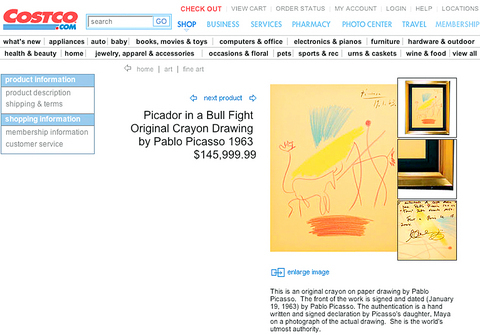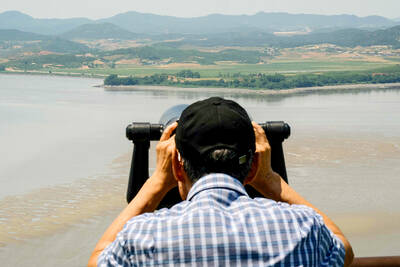Maya Widmaier-Picasso, a daughter of Picasso who authenticates works attributed to him, said last week in Paris that a US$40,000 drawing purchased by a California man through Costco last year was a fake.
Widmaier-Picasso, 70, was asked to view a digital image of the 1970 drawing three days after she pronounced two other Picassos inauthentic that had been offered by the same US dealer who sold the drawing.
Those two works, photographs of which were shown to her by The New York Times, were offered by the dealer with certificates in French saying that Widmaier-Picasso had authenticated them. Pointing to anomalies in the certificates -- grammatical errors, wording that departed from her style, handwriting that did not match hers and the placement of words on the page -- the artist's daughter said both documents were forgeries.

PHOTO: NY TIMES NEWS SERVICE
One of the sketches, a 1963 drawing of a bullfight that was being offered through Costco for US$146,000, was removed from the company's retail Web site, www.costco.com, after The Times informed Costco of Widmaier-Picasso's contention. Since then, Costco has been bombarded with inquiries about how it screens the fine art offered through its Web site and at "special events" at its store outlets. As the company investigates Widmaier-Picasso's assertions, it has emphasized that any of its merchandise can be returned.
The other drawing that Widmaier-Picasso examined on Tuesday was presented to her in error. The drawing's supplier, Jim Tutwiler of Boca Raton, Florida, had provided it to The Times and misidentified it as the one sold through Costco to the California man, Louis Knickerbocker of Newport Beach.
Friday, upon viewing the correct image of the work that Knickerbocker owns -- a crayon drawing of a face dated 1970 -- Widmaier-Picasso said immediately, "Ah yes, Arias, my father's barber."
After inspecting it rapidly, the artist's daughter, a stocky, ebullient 70-year-old who strongly resembles her father, declared the work to be a fake -- a copy of a genuine Picasso.
She arose, went into another room and returned with a catalog depicting works from the Eugenio Arias Collection, which resides in the permanent collection of the Picasso Museum of Buitrago del Lozoya, a town near Madrid. The museum was founded in 1985, three years after Arias, the artist's longtime barber and a native of Buitrago, donated his small Picasso collection -- "lots of little things given to him by my father," Widmaier-Picasso said.
She turned to a catalog page with a sketch of Arias' face that closely resembled the one sold to Knickerbocker. It bore the same date: Nov. 29, 1970. She explained that Picasso sketched the barber's face on the title page of a short play he had written, The Burial of the Count of Orgaz, a copy of which he dedicated to Arias.
Picasso's handwriting was markedly different from the writing on the work sold through Costco, Widmaier-Picasso pointed out -- especially the way he formed the R and the S in Arias. In the sketch reproduced in the catalog, she noted, the R had a loop, and the S was rounded; in Knickerbocker's drawing, the letters are not articulated as clearly. And in the date, Picasso's 9 had a full circle at the top of the vertical line, she noted, whereas the circle in the image shown was open.
Throughout the works in the catalog, the lettering of every Arias was consistent -- and unlike the Arias scrawled on Knickerbocker's drawing.
Told of Widmaier-Picasso's finding by telephone, Costco's senior vice president for e-commerce, Ginnie Roeglin, abruptly ended the conversation.
Later she released a statement saying: "To the best of our knowledge, Maya Picasso has not reviewed the certificates of authenticity bearing her signature for two Picasso pieces that we have sold. Our sources continue to assure us that the certificates as well as the art are genuine."
It was not clear exactly what Picassos Roeglin was referring to -- the ones viewed by the artist's daughter on Tuesday and Friday, or others sold through Costco. Calls to her later were not returned.
Her statement said that Costco was still investigating "to resolve the questions" raised by Widmaier-Picasso's remarks and that any Picassos sold by the store chain could be returned for a full refund.
Calls to Jim Sinegal, Costco's chief executive, were not returned Friday.
Widmaier-Picasso, who has authenticated works for Sotheby's and Christie's, says she keeps a detailed record on every photographic certificate she issues. She staples a sticker to the back of each one, marked with one or more of her fingerprints, she says, and keeps a record of which fingers were used in each case.
Art scholars have occasionally dissented from her attributions and deattributions, although rarely publicly. But in any case, Widmaier-Picasso has challenged certificates of authenticity bearing her name that she was shown this week in digital form.
She has not seen a photograph of the one provided to Knickerbocker. Costco declined again Friday to provide an image of the certificate, and Knickerbocker did not return phone calls. Repeated knocks on the door of his Spanish-style house in Newport Beach went unanswered late Friday morning.

In the next few months tough decisions will need to be made by the Taiwan People’s Party (TPP) and their pan-blue allies in the Chinese Nationalist Party (KMT). It will reveal just how real their alliance is with actual power at stake. Party founder Ko Wen-je (柯文哲) faced these tough questions, which we explored in part one of this series, “Ko Wen-je, the KMT’s prickly ally,” (Aug. 16, page 12). Ko was open to cooperation, but on his terms. He openly fretted about being “swallowed up” by the KMT, and was keenly aware of the experience of the People’s First Party

Aug. 25 to Aug. 31 Although Mr. Lin (林) had been married to his Japanese wife for a decade, their union was never legally recognized — and even their daughter was officially deemed illegitimate. During the first half of Japanese rule in Taiwan, only marriages between Japanese men and Taiwanese women were valid, unless the Taiwanese husband formally joined a Japanese household. In 1920, Lin took his frustrations directly to the Ministry of Home Affairs: “Since Japan took possession of Taiwan, we have obeyed the government’s directives and committed ourselves to breaking old Qing-era customs. Yet ... our marriages remain unrecognized,

During the Metal Ages, prior to the arrival of the Dutch and Chinese, a great shift took place in indigenous material culture. Glass and agate beads, introduced after 400BC, completely replaced Taiwanese nephrite (jade) as the ornamental materials of choice, anthropologist Liu Jiun-Yu (劉俊昱) of the University of Washington wrote in a 2023 article. He added of the island’s modern indigenous peoples: “They are the descendants of prehistoric Formosans but have no nephrite-using cultures.” Moderns squint at that dynamic era of trade and cultural change through the mutually supporting lenses of later settler-colonialism and imperial power, which treated the indigenous as

Standing on top of a small mountain, Kim Seung-ho gazes out over an expanse of paddy fields glowing in their autumn gold, the ripening grains swaying gently in the wind. In the distance, North Korea stretches beyond the horizon. “It’s so peaceful,” says the director of the DMZ Ecology Research Institute. “Over there, it used to be an artillery range, but since they stopped firing, the nature has become so beautiful.” The land before him is the demilitarized zone, or DMZ, a strip of land that runs across the Korean peninsula, dividing North and South Korea roughly along the 38th parallel north. This